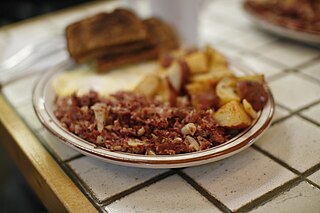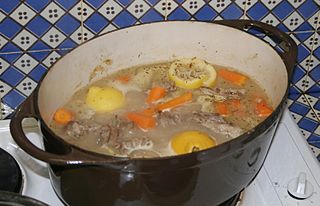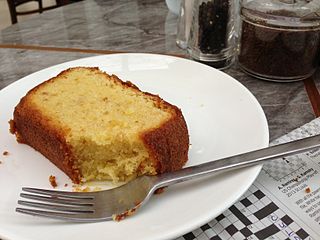
Mushroom sauce is a white or brown sauce prepared using mushrooms as its primary ingredient. It can be prepared in different styles using various ingredients, and is used to top a variety of foods.

Mushroom sauce is a white or brown sauce prepared using mushrooms as its primary ingredient. It can be prepared in different styles using various ingredients, and is used to top a variety of foods.

In cooking, mushroom sauce is sauce with mushrooms as the primary ingredient. Often cream-based, [1] it can be served with veal, chicken and poultry, pasta, and other foods such as vegetables. [2] [3] [4] [5] Some sources also suggest pairing mushroom sauce with fish. [6]
It is made with mushrooms, butter, cream [7] or olive oil, white wine (some variations may use a mellow red wine) and pepper with a wide variety of variations possible with additional ingredients such as shallot, garlic, lemon juice, flour (to thicken the sauce), chicken stock, saffron, basil, parsley, or other herbs. [8] [9] It is a variety of allemande sauce.
Mushroom sauce can also be prepared as a brown sauce. [10] [11] Canned mushrooms can be used to prepare the sauce. [12]
For vegan dishes, cream can be replaced with ground almonds, mixed with water and evaporated until needed consistency.
Mushroom sauces have been cooked for hundreds of years. An 1864 cookbook includes two recipes, one sauce tournee and one a brown gravy. [13]
United States President Dwight D. Eisenhower, a well-known steak lover, was reportedly quite fond of mushroom sauce. [14]

Espagnole sauce is a basic brown sauce, and is one of the mother sauces of classic French cooking. In the early 19th century the chef Antonin Carême included it in his list of the basic sauces of French cooking. In the early 20th century Auguste Escoffier named it as one of the five sauces at the core of France's cuisine.

Tomato sauce can refer to many different sauces made primarily from tomatoes, usually to be served as part of a dish, rather than as a condiment. Tomato sauces are common for meat and vegetables, but they are perhaps best known as bases for sauces for Mexican salsas and Italian pasta dishes. Tomatoes have a rich flavor, high water content, soft flesh which breaks down easily, and the right composition to thicken into a sauce when stewed without the need for thickeners such as roux or masa. All of these qualities make them ideal for simple and appealing sauces.

In cooking, a sauce is a liquid, cream, or semi-solid food, served on or used in preparing other foods. Most sauces are not normally consumed by themselves; they add flavor, moisture, and visual appeal to a dish. Sauce is a French word taken from the Latin salsa, meaning salted. Possibly the oldest recorded European sauce is garum, the fish sauce used by the Ancient Romans, while doubanjiang, the Chinese soy bean paste is mentioned in Rites of Zhou in the 3rd century BC.

Tartar sauce is a condiment made of mayonnaise, chopped pickles and relish, caper, and herbs such as tarragon and dill. Tartar sauce can also be enhanced with other herbs, lemon juice, and olives. It is most often served with seafood dishes such as fish and chips, fish sandwiches, fish fingers, fried oysters, and calamari.

Gravy is a topping or sauce often made from the juices of meats that run naturally during cooking and often thickened with corn starch for added texture. The gravy may be further coloured and flavoured with gravy salt or gravy browning or ready-made cubes. Powders can be used as a substitute for natural meat or vegetable extracts. Canned and instant gravies are also available. Gravy is commonly served with roasts, meatloaf, rice, noodles, chips (fries), mashed potatoes, or biscuits.

Lasagna is a type of pasta, possibly one of the oldest types, made of very wide, flat sheets. Either term can also refer to an Italian dish made of stacked layers of lasagna alternating with fillings such as ragù, béchamel sauce, vegetables, cheeses, and seasonings and spices. The dish may be topped with grated cheese, which becomes melted during baking. Typically cooked pasta is assembled with the other ingredients and then baked in an oven. The resulting baked pasta is cut into single-serving square or rectangular portions.

Hash is a dish consisting of chopped meat, potatoes, and fried onions. The name is derived from French: hacher, meaning 'to chop'. It originated as a way to use up leftovers. In the U.S. by the 1860s, a cheap restaurant was called a "hash house" or "hashery."

Blanquette de veau is a French veal stew. In the classic version of the dish the meat is simmered in a white stock and served in a sauce velouté enriched with cream and egg. It is among the most popular meat dishes in France.

Moussaka is an eggplant- or potato-based dish, often including ground meat, which is common in the Balkans and the Middle East, with many local and regional variations.

A schnitzel is a thin slice of meat. The meat is usually thinned by pounding with a meat tenderizer. Most commonly, the meat is breaded before frying. Breaded schnitzel is popular in many countries and is made using veal, pork, chicken, mutton, beef, or turkey. Schnitzel is very similar to the dish escalope in France and Spain, panado in Portugal, tonkatsu in Japan, cotoletta in Italy, kotlet schabowy in Poland, milanesa in Latin America, chuleta valluna in Colombia, chicken chop in Malaysia, and chicken-fried steak and pork tenderloin of the United States.

A velouté sauce is a savory sauce that is made from a roux and a light stock. It is one of the "mother sauces" of French cuisine listed by chef Auguste Escoffier in the early twentieth century, along with espagnole, tomato, béchamel, and mayonnaise or hollandaise. Velouté is French for 'velvety'.

Eliza Acton was an English food writer and poet who produced one of Britain's first cookery books aimed at the domestic reader, Modern Cookery for Private Families. The book introduced the now-universal practice of listing ingredients and giving suggested cooking times for each recipe. It included the first recipes in English for Brussels sprouts and for spaghetti. It also contains the first recipe for what Acton called "Christmas pudding"; the dish was normally called plum pudding, recipes for which had appeared previously, although Acton was the first to put the name and recipe together.

Italian-American cuisine is a style of Italian cuisine adapted throughout the United States. Italian-American food has been shaped throughout history by various waves of immigrants and their descendants, called Italian Americans.

Fricassee or fricassée is a stew made with pieces of meat that have been browned in butter then served in a sauce flavored with the cooking stock. Fricassee is usually made with chicken, veal or rabbit, with variations limited only by what ingredients the cook has at hand.

Cream of mushroom soup is a simple type of soup where a basic roux is thinned with cream or milk and then mushrooms and/or mushroom broth are added. It is well known in North America as a common type of condensed canned soup. Cream of mushroom soup is often used as a base ingredient in casseroles and comfort foods. This use is similar to that of a mushroom-flavored gravy.

Soup is a primarily liquid food, generally served warm or hot, that is made by combining ingredients of meat or vegetables with stock, milk, or water. Hot soups are additionally characterized by boiling solid ingredients in liquids in a pot until the flavors are extracted, forming a broth. Soups are similar to stews, and in some cases there may not be a clear distinction between the two; however, soups generally have more liquid (broth) than stews.

Modern Cookery for Private Families is an English cookery book by Eliza Acton. It was first published by Longmans in 1845, and was a best-seller, running through 13 editions by 1853, though its sales were later overtaken by Mrs Beeton. On the strength of the book, Delia Smith called Acton "the best writer of recipes in the English language", while Elizabeth David wondered why "this peerless writer" had been eclipsed by such inferior and inexperienced imitators.

The Eurasian cuisine is a 'fusion' cuisine, mainly existing and found in the countries of Singapore and Malaysia.